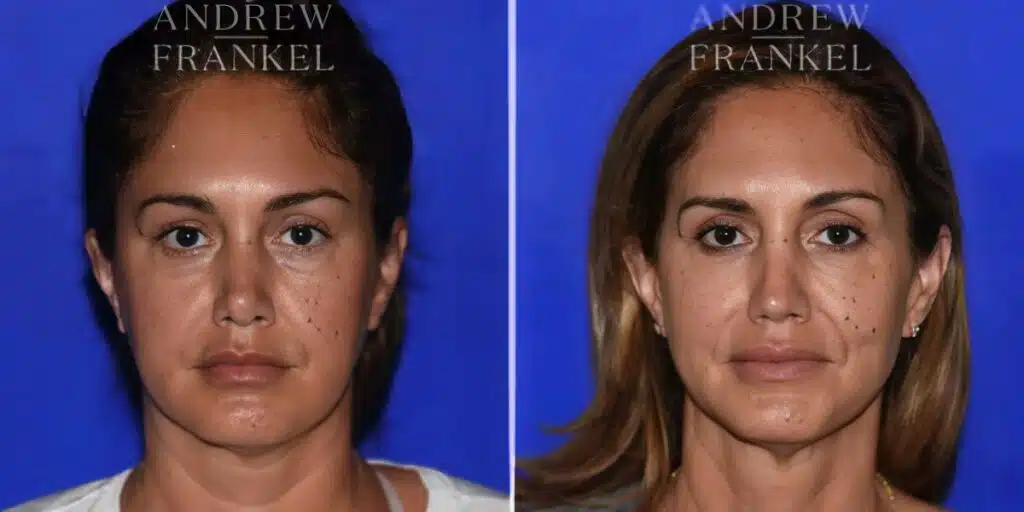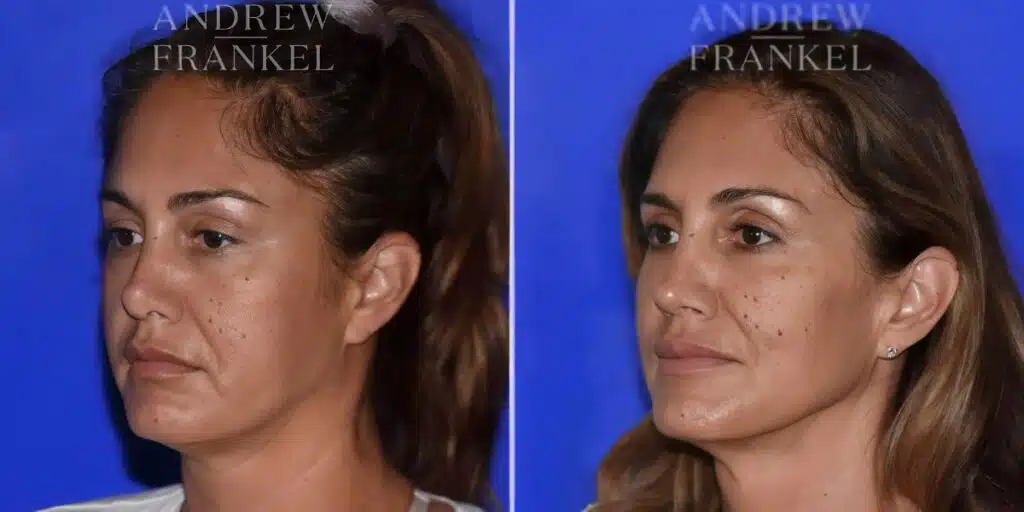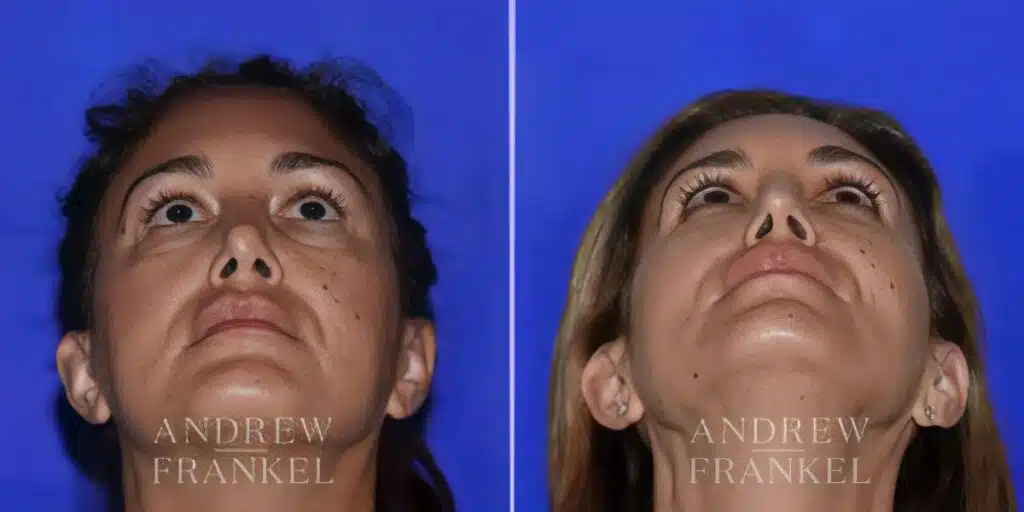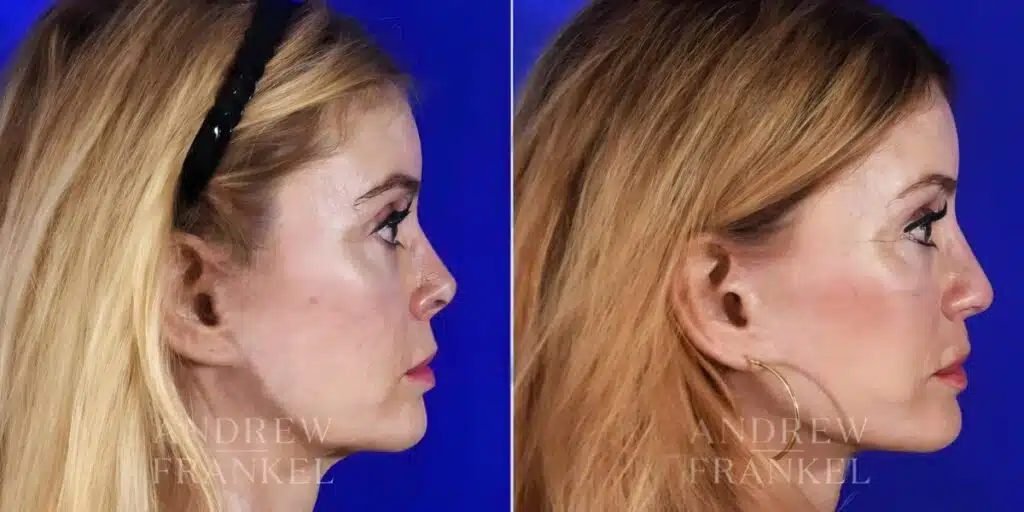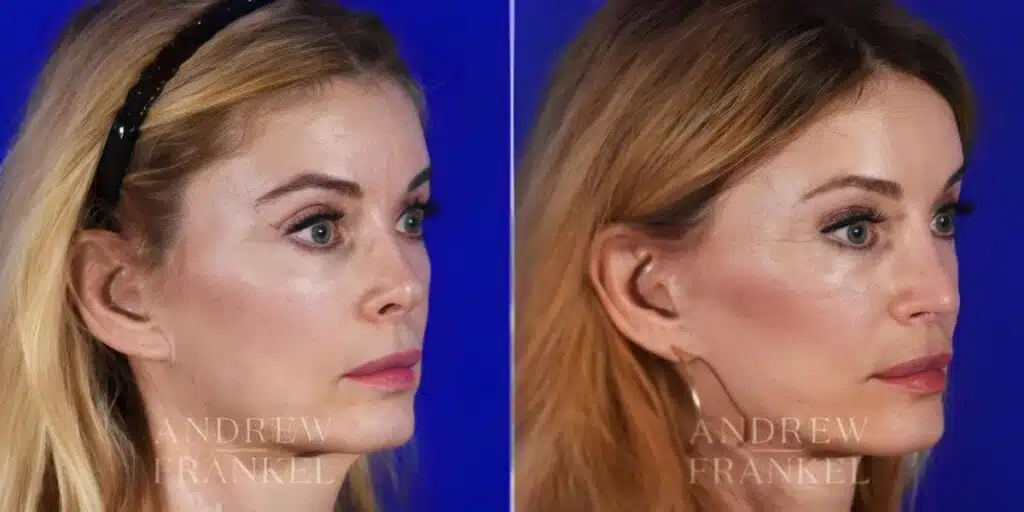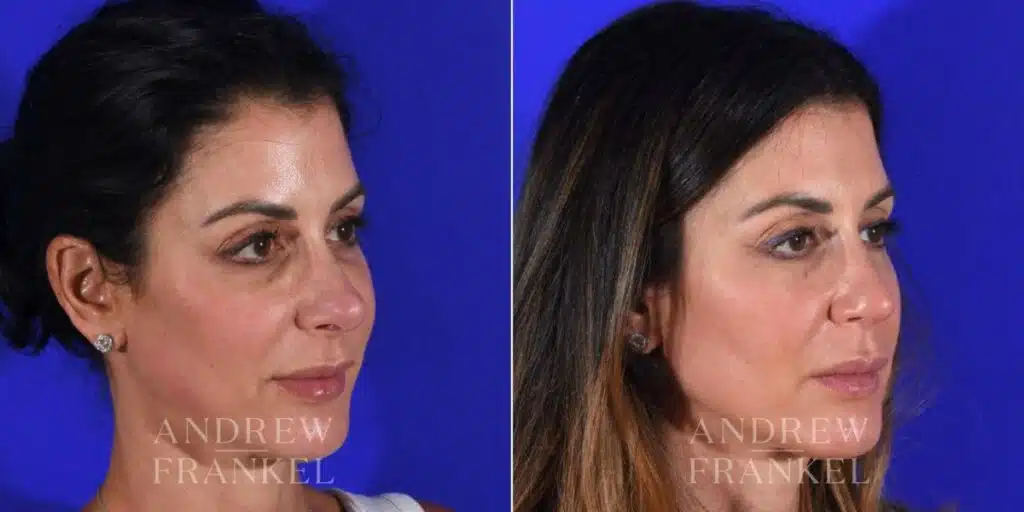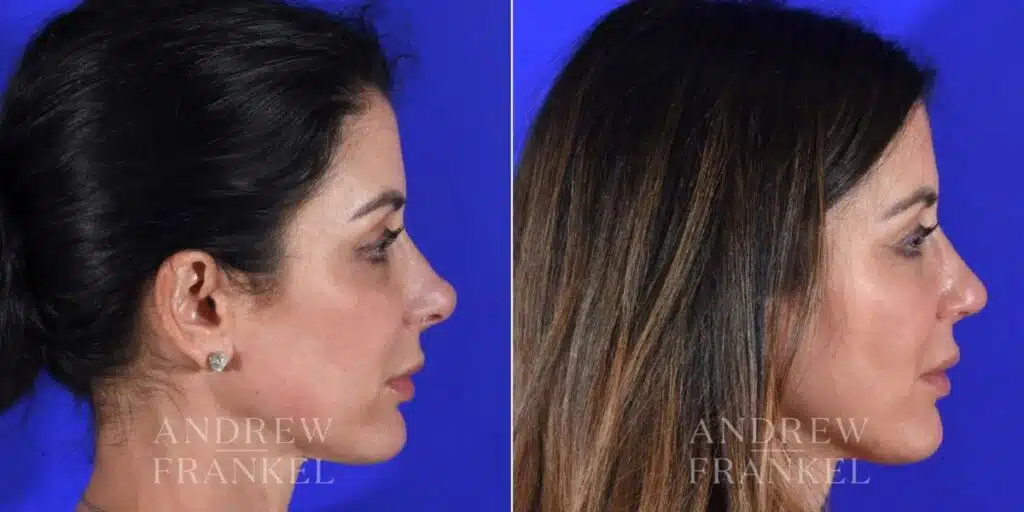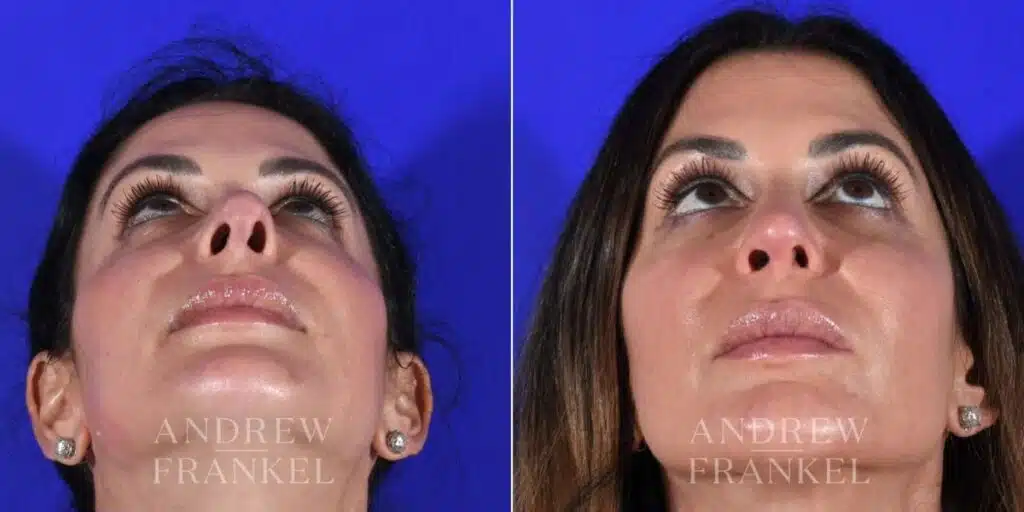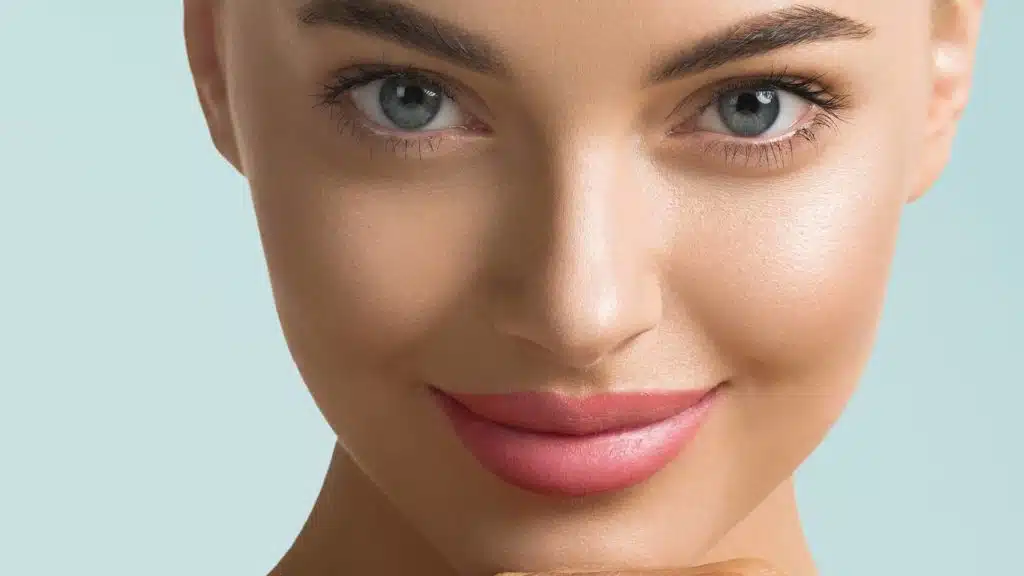
Unhappy with Your High Nose Tip After Rhinoplasty? Correct It and Restore Balance
A nose tip too high after rhinoplasty or a pinched nose tip after rhinoplasty can leave you feeling as if the surgery you waited months—or years—to schedule missed the mark. Instead of the graceful profile you pictured, your nose may look up‑turned, overly projected, or narrowed to the point of collapse. If this sounds familiar, take heart: Modern revision techniques can correct these problems, restore balance to your face, and give you the breathing comfort you deserve.
Dr. Andrew Frankel is a double-board-certified facial plastic surgeon in Beverly Hills who devotes a significant part of his practice to complex revision work. Patients travel from across the United States, Europe, and even Asia to see him because his results look natural, function well, and age gracefully. Below, you’ll learn why a nose tip can end up too high, how a pinched tip develops, and—most importantly—the proven ways Dr. Frankel brings the tip back into harmony with the rest of the nose.
Why Your Nose Tip Might Look Too High or Pinched After Rhinoplasty
Even an experienced plastic surgeon faces challenges when reshaping the delicate cartilage that supports the tip. Small miscalculations can translate into big cosmetic or breathing issues once swelling subsides.

Common Reasons for a Raised or Over-Projected Tip
An over-rotated tip (sometimes called “pig-nose”) often stems from one of three factors:
- Excessive cartilage removal. When too much of the lower lateral cartilage is trimmed, the remaining structure can recoil upward.
- Aggressive suturing techniques. Certain stitches intentionally rotate the tip but, if overdone, leave the nostrils visible from the front.
- Postoperative scar contracture. As internal scar tissue shrinks, it can pull the tip skyward—especially in thick-skin patients whose swelling hides early warning signs
What Causes a Pinched Nose Tip After Surgery?
A pinched tip feels narrow, stiff, or collapsed when you press the nostrils. Contributing factors include:
- Cartilage weakness. Thin or over-resected cartilages can buckle inward.
- Loss of support grafts. Grafts that were never placed—or were placed but then resorbed—fail to hold the tip shape.
- Internal valve collapse. When the side walls cave in, both breathing and appearance suffer.
How Surgical Technique and Healing Can Affect Your Final Look
Every rhinoplasty involves swelling, but the degree and duration vary. In some cases, what seems like a high tip at three months settles to perfection by the one-year mark—a process known as tip drop. In others, lingering edema or scar bands exaggerate problems. Dr. Frankel tracks each patient’s progress through the critical first 18 months, recommending targeted skin care treatments, gentle massage, and, when appropriate, steroid injections to control swelling after rhinoplasty.
Fixing a High or Pinched Nose Tip with Revision Rhinoplasty
Revision rhinoplasty is more than a “do-over.” It requires rebuilding structure, repositioning cartilage, and refining the soft-tissue envelope—all while preserving (or restoring) nasal airflow. Dr. Frankel typically performs revision surgery under twilight anesthesia at the accredited Lasky Clinic Surgical Center, using a meticulous, step-by-step approach:
- Precise analysis. Digital imaging helps you and Dr. Frankel agree on realistic goals for bridge and tip alignment.
- Structural grafting. Cartilage from the septum, ear, or rib reinforces weak areas, lowers an elevated tip, and opens narrowed nostrils.
- Soft-tissue management. Scar tissue is carefully released; thick skin is thinned only when safe.
- Support sutures. Stitches secure grafts, refine tip definition, and prevent future warping.
Revitalize with Dr. Frankel
Step into a world where beauty blends with science, and let Dr. Frankel guide you to a refreshed, youthful appearance.
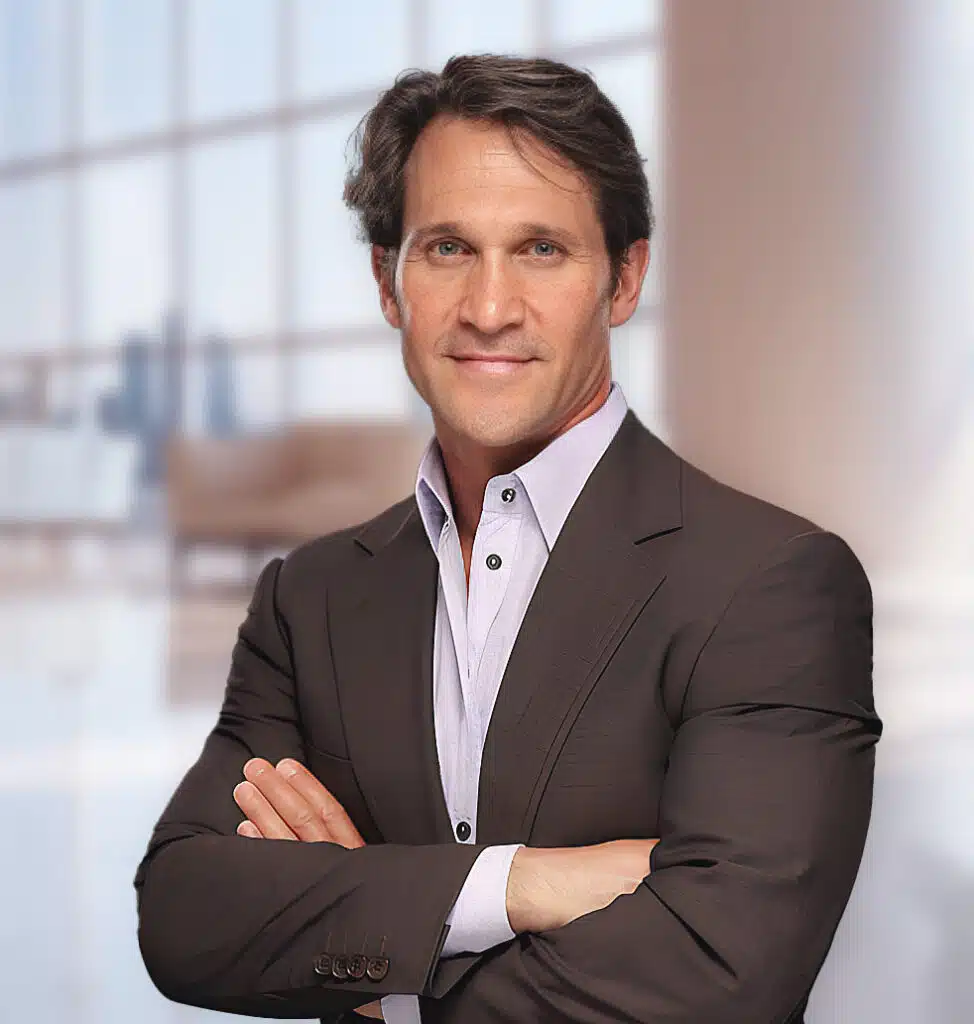
Real Patient Experiences with Nose Tip Correction
Seeing real‑world outcomes can ease anxiety and clarify expectations. The following three cases involving Dr. Frankel’s patients show how diverse problems are corrected with equally individualized solutions.
Case 1: Transforming a Pinched and Over‑Rotated Nasal Tip for Improved Breathing and Aesthetics
This female patient arrived unable to breathe without external nasal tape. Her prior surgery left her tip pinched, rotated upward, and structurally weak. Dr. Frankel harvested rib cartilage, rebuilt the side walls, and re‑created the tip with stable grafts. Eighteen months later, she enjoys a softer profile, natural nostrils, and effortless airflow—proof that function and beauty can coexist.
Case 2: Lengthening a Short, Upturned Nose for a More Natural Look
Feeling that her “cute” nose looked artificial, this patient asked Dr. Frankel to counter‑rotate and lengthen the tip. Using rib cartilage, he extended the septum, lowered projection, and improved internal support. Post‑op photos reveal a refined yet unoperated appearance that blends seamlessly with the rest of her facial features.
Case 3: Correcting a Disfigured Nasal Tip After Multiple Surgeries
After two unsuccessful procedures, this woman’s nasal tip was distorted and scarred. Dr. Frankel removed a malpositioned rib graft, salvaged usable cartilage, and artfully rebuilt the tip. The result: a balanced, confident profile and a renewed sense of self-esteem.
Options to Restore Natural‑Looking Balance with Nose Surgery
No two noses—or faces—are alike, so Dr. Frankel tailors each technique to your anatomy and goals. Before diving into specific options, remember that revision surgery is about restoration, not radical change. The aim is to harmonize the nose with the rest of your face, not draw new attention to it.
Adjusting Projection Without Overcorrecting
Lowering a high tip usually involves:
- Septal extension grafts that lengthen support without widening the nose bridge.
- Shield grafts that refine definition while keeping the nostrils in proportion.
- Careful cartilage trimming—never more than necessary—to avoid future collapse.
Tip Rotation and Support Techniques Explained Simply
If your tip still turns upward after primary rhinoplasty by another surgeon, Dr. Frankel may:
- Release tight scar bands that tether the tip.
- Reposition lower lateral cartilages to a more natural angle.
- Secure new grafts to maintain the corrected rotation long-term.
Managing Swelling After Rhinoplasty and Understanding Tip Drop
Most patients see 80% of swelling resolve within six months, but the final 20%—especially around the tip—can take a full year. Dr. Frankel provides a detailed timeline, recommends anti-inflammatory skin care treatments, and schedules check-ins to make sure tip drop progresses predictably.
Revision Concerns for Men: Male Plastic Surgery Insights
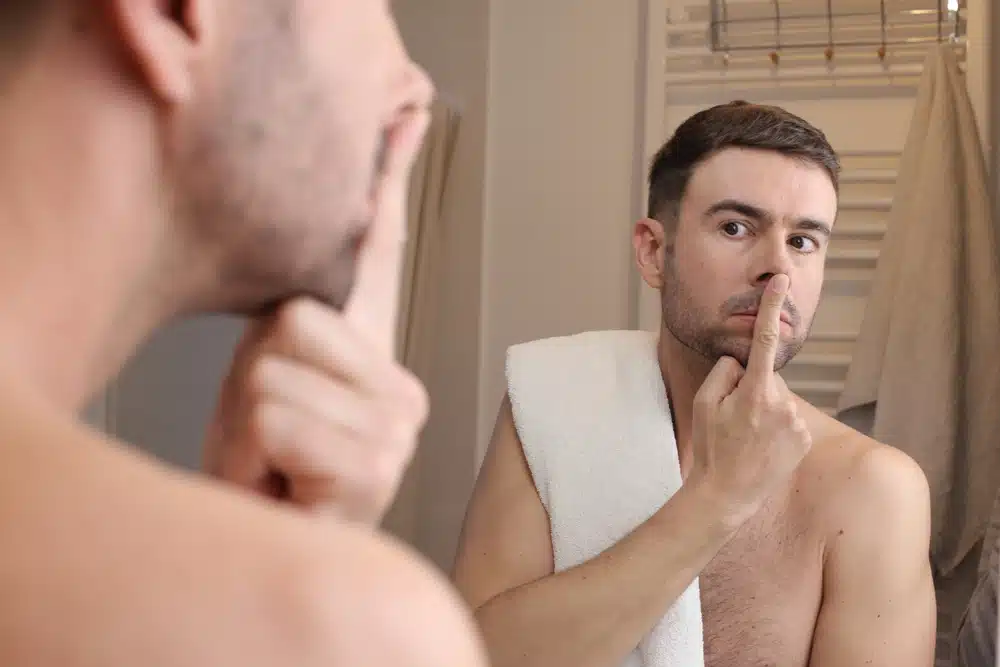
Men often seek a straighter, stronger nose bridge and a tip that looks defined, not delicate. Revision goals may include:
- Preserving masculine angles while lowering an over‑rotated tip.
- Widening a pinched valve to improve airflow for sports or sleep.
- Avoiding feminizing cues through subtle cartilage graft placement.
Dr. Frankel’s experience in male rhinoplasty and male plastic surgery helps him respect gender‑specific aesthetics while correcting past mistakes.
Complementary Procedures: Eyelid Plastic Surgery and Skin Care Treatments for a Refreshed Face
A balanced nose draws the eye to other facial highlights—like bright, rested eyes and smooth skin. Some patients combine revision rhinoplasty with eyelid plastic surgery (blepharoplasty) or laser‑based skin care treatments to create an overall rejuvenated look. Because all procedures occur within the same accredited surgical center, you enjoy one recovery period and a cohesive result.
Choosing the Right Revision Rhinoplasty Surgeon
Revision rhinoplasty is widely viewed as the most technically demanding task in facial plastic surgery. Scar tissue, depleted cartilage, and a nose that has already been reshaped leave far less margin for error than a first-time nose job.
Why Not Every Nose Surgeon Specializes in Revision Work
General plastic surgeons may perform occasional revisions, but few focus on them full‑time. Look for:
- Board certification in facial plastic surgery—it proves specialized training.
- Before‑and‑after galleries showing cases similar to yours.
- Transparent discussion of risks, benefits, and realistic outcomes.
Why Dr. Andrew Frankel is Trusted for Complex Revisions in Beverly Hills
Dr. Frankel’s résumé includes:
- Dual board certification (Otolaryngology–Head & Neck Surgery and Facial Plastic & Reconstructive Surgery).
- 25 + years of exclusive focus on surgical nose jobs and related facial procedures.
- Frequent invitations to speak on revision techniques for the American Academy of Facial Plastic and Reconstructive Surgery (AAFPRS) and leading plastic surgery podcasts.
- A private, concierge-style practice where every consultation and follow-up is with Dr. Frankel—not an associate.
Unhappy with the results of a previous nose job? Take the first step toward a nose that truly fits your face—book an in-person or virtual consultation today.
Looking for a Fix That Feels Right? Let’s Talk
A high or pinched tip doesn’t have to be your new normal. With advanced revision rhinoplasty, Dr. Andrew Frankel can lower the tip, widen pinched areas, and give you a nose that looks like it always belonged on your face. From the first consultation to the final post-op check, you’ll receive personalized care, honest guidance, and the artistry of a surgeon who sees revision work as both a challenge and a calling.
Take the next step today. Call (310) 873-6556 or submit the online form to reserve your consultation. Reclaim comfortable breathing, balanced proportions, and renewed confidence—because you deserve a result that feels as good as it looks.
